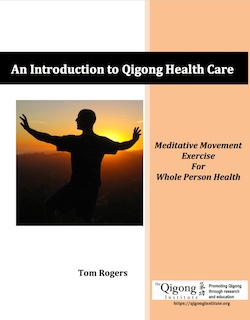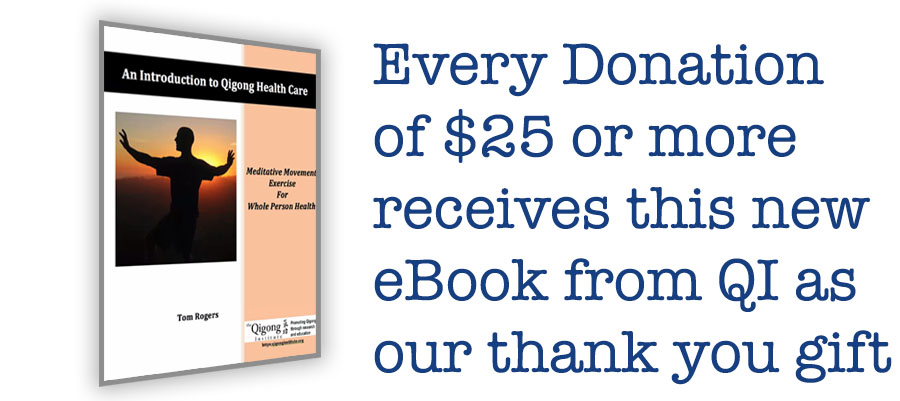Reviews of
An Introduction to Qigong Health Care
“Since its founding under the leadership of the late Ken Sancier, the Qigong Institute has served as an objective organization for gathering and disseminating scientific evidence supporting the health benefits of Qigong and related practices. The Institute’s latest report, An Introduction to Qigong Health Care: Meditative Movement Exercise for Whole Person Health—authored by Tom Rogers—is a comprehensive and very accessible resource for all interested in Qigong for health, including practitioners, teachers, scientists and policy makers. “
Peter Wayne, PhD
Associate Professor of Medicine
Director, Osher Center for Integrative Health
Harvard Medical School
Author, Harvard Medical School Guide to Tai Chi
“Tom Rogers and the Qigong Institute have done a wonderful job of curating the rapidly growing body of peer-reviewed research on the psychological and physiological health-related benefits of Qigong and Tai Chi. In addition to providing a degree of relief for a number of persistent symptoms and quality of life issues for cancer patients and survivors, as moderate-intensity exercise they are safe for people with chronic health conditions, physical limitations, and older adults. They also provide accessible exercise programming for more frail, home or chair-bound, healthy or unhealthy elderly, and chronically ill. Tom brings together in one place a body of scientific knowledge explaining the fundamentals of the practices and provides a synthesis for creating primary prevention behaviors and community-based health practices which can be disseminated widely and encourage easy and affordable at-home care for individuals to take charge of their health. “
Linda Larkey, PhD
Professor, Edson College of Nursing and Health Innovation
Arizona State University
"Qigong fosters mind-body integration through the practice and refinement of interoception skills that characterize Qigong and all Meditative Movement exercises. The integration of body movement, breath practice and present moment focus to enhance mind-body function and coherence encourages and promotes adaptation, resilience, and sustainable wellbeing. Tom Rogers and the Qigong Institute have produced a powerful cross-disciplinary reference document for any policy makers, funders, teachers, medical professionals, clinicians, and academics wishing to raise health status, reduce medical costs, and empower everyone to create health. ”
Dr. Roger Jahnke, OMD
Dr. of Chinese Medicine
Director of the Institute of Integral Qigong and Tai Chi (IIQTC)
Author, The Healer Within.
Read the entire eBook PDF. DONATE.





 The goal of Qigong Health Care is to widen the definition of the word “medical” to include and emphasize health, wellness, and prevention as well as intervention and acute care. Self-care fits in prevention and overall health management, and it is a life-long skill that must be consistently practiced over time in order to maintain the benefit. Central to Qigong Health Care is appropriate and long lasting behavior change. This invites the consumer of health care services to take an active role in pursuing health. Consequently, the important line between education and treatment provides a guide for how hospitals and clinics can teach patients health cultivation skills through offering Qigong and wellness classes as behavioral health interventions. When patients take wellness and health cultivation classes (Qigong, yoga, and the like), they learn how to positively affect their own body and behavior to become active participants in creating their own health and healing. Qigong provides a way to give patients an empowering and tangible exercise to bring a positive perspective and personal participation to their healing and creation of health. This type of "take-home" exercise is what physicians and health care providers can offer patients instead of or in addition to prescribing medication. Getting patients into receptive and healing states through Qigong and related wellness practices can support them throughout treatment and therapy, and thereby increase the likelihood of positive outcomes.
The goal of Qigong Health Care is to widen the definition of the word “medical” to include and emphasize health, wellness, and prevention as well as intervention and acute care. Self-care fits in prevention and overall health management, and it is a life-long skill that must be consistently practiced over time in order to maintain the benefit. Central to Qigong Health Care is appropriate and long lasting behavior change. This invites the consumer of health care services to take an active role in pursuing health. Consequently, the important line between education and treatment provides a guide for how hospitals and clinics can teach patients health cultivation skills through offering Qigong and wellness classes as behavioral health interventions. When patients take wellness and health cultivation classes (Qigong, yoga, and the like), they learn how to positively affect their own body and behavior to become active participants in creating their own health and healing. Qigong provides a way to give patients an empowering and tangible exercise to bring a positive perspective and personal participation to their healing and creation of health. This type of "take-home" exercise is what physicians and health care providers can offer patients instead of or in addition to prescribing medication. Getting patients into receptive and healing states through Qigong and related wellness practices can support them throughout treatment and therapy, and thereby increase the likelihood of positive outcomes.